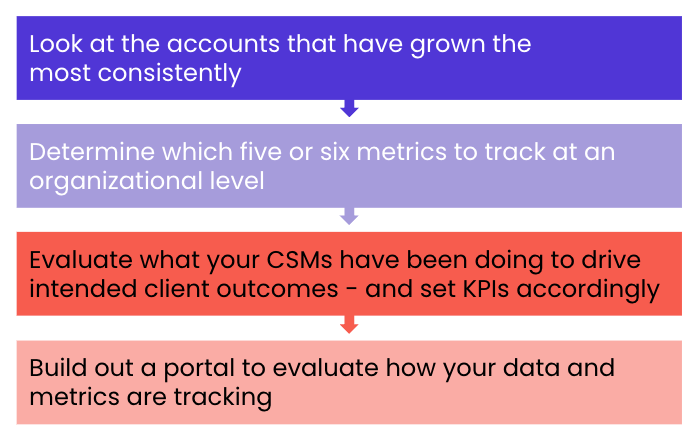The phrase “data is the new oil” becomes truer every day. Data is the lubricant that greases the wheels of the fourth industrial revolution we’re living through.
Think about your smartphone; it has a whopping 128GB, which seems like more storage than you’ll ever need, right? Well, it’s estimated that humanity creates 300 billion gigabytes every day! And this is rapidly accelerating as more people in more countries do more online - including businesses.
In short, your company will soon be creating a hell of a lot of data points - if they’re not already. As a customer success leader interpreting your customers’ engagement and activity through data, you’re going to need to familiarize yourself with all that amazing data to do, well, anything frankly!
So, you’ve got all this data, what next? In this article, we’ll explore:
- Where this data will likely come from,
- The importance of data sources and the risks or inconsistencies, and
- How to turn these data points into insights, and where you can deploy them.
The four crucial data sources for customer success operations
There are four primary sources of data in most companies that need a CS function:
- Product
- Customer relationship management
- Financial
- Third party
Product
Every online tool creates data points. From simple stuff like when a user has logged in, and how long for, through to when they’ve interacted with certain features, and in what order. This kind of usage data is critical to a CS function and you’re going to need to ensure that your team can access it swiftly and in a digestible format.
The main risk with this kind of data tends not to be its integrity (after all, a computer can’t forget to log in when a client has logged in!) but rather it’s the sheer volume. With so many data points being created, you’ll need to work with your product team to:
- Ensure that they have crystal clear definitions of what each metric is (i.e. how you define a “session” when someone logs in.
- Focus on a relatively short list of metrics that matter to your org. Otherwise, you risk drowning your team in a sea of intermittently useful data. Understanding and proving value is a good filter to use if you do have lots of data!
CRM
Critical to any business is knowing what you have done, are doing, and what you intend to do with each client or prospect; hence the CRM. Making sure that you have a strong internal culture of recording information is critical to making business decisions.
Fortunately, there are a number of productivity tools available that auto-record emails or calls to reduce the administrative burden on your team. Automation can also help to reduce the biggest risk with this type of data, which is that people hate admin and aren’t always going to record everything accurately and on time.
Being able to accurately show how much time you’ve spent on a customer is critical when it comes to justifying building out your team.
Financial
This is the ultimate truth for any business. The big questions the C-suite will want to know are:
- How much have you sold,
- How much have you renewed, and
- Has this been achieved on time (early or late)?
Now, this is typically taken care of by a sales function (or a Sales Ops function, if you’re a larger company) so it’s vital that you’re being fed this same information in a timely manner.
On the flip side to income is, of course, costs. Working with your HR team to determine an approximate cost per year of each member of staff, as well as the cost of hiring a new staff member enables you to evaluate the overall financial impact of your strategic decisions.
Third party
There’s data and information out there on every company; how well they’re performing, if they’re hiring, etc. – it’s well worth looking to supplement what you know about your client base with third-party information.
The risks and downside to this data are that you likely have no way of verifying it - therefore it’s best to not rely too much on this data but use it to complement your other sources.
Invest in your customer success team through learning and development
I’ve partnered with Customer Success Collective to produce a new program that answers this need, and more: Building a Customer Success Team Certified.
During this course, you’ll learn how to:
🔧 Leverage technology and automation to streamline customer success operations and improve efficiency.
🧑🎨 Sculpt out a strong CS function and learn for your business, including where CS slots into the client experience and why it’s an investment for the future.
🎨 Create effective customer onboarding processes and ensure a seamless transition from sales to customer success that sets the stage for long-term relationships.
🧱 Build a culture of continuous improvement by cultivating a mindset of learning and growth within your customer success team.
Transforming data into insights
So you’ve got all this data, but by itself, it’s not that helpful. Without diving into the rabbit hole of statistical analysis, one of the best ways of looking at that one data point is just that: data. Combined with another data point and a hypothesis, it becomes an insight. Combining your financial and usage data together with knowledge about your product will help you gain insight into the mass of data.
For example, “data point one” could be that multiple clients have grown at renewal after years of renewing flat.
“Data point two” is from your CRM, showing that 80% of these clients have engaged with an executive at your company in the six months leading up to their renewal.
Now if you also know that the most common purchaser of your product is a Chief HR Officer then you can develop the insight that CHROs need to be engaged by your company’s execs at least once a year to help grow their investment with you.
Identifying high-performance accounts: A top-down approach
So what about customer success-specific data and where should you be looking to deploy it to? We’re going to work at this tops-down.

Start by looking at which accounts have grown the most, or perhaps the most consistently. What are the common characteristics that they share in the two separate (but not unrelated) areas of product usage and CSM engagement?
From this, you should be able to determine which metrics you want to track at an org level. This is what you’ll need to report to your exec leadership team - to inform them of the health of your client base and how the CS function is performing next to its ultimate goal of ensuring strong renewals and low churn rates.
Let’s take it down now to the individual contributor level.
You know which activities you want your clients to be undertaking as they’re statistically more likely to be successful using your product and renew more easily, such as evaluating how swiftly licenses are activated/logged in to and comparing this to historical renewal data. From this, evaluate what your CSMs have been doing on those accounts to drive that action and set KPIs accordingly.
The final step in looking at CSM data and metrics is to build out a portal (and hopefully you have a CS Ops person to help with this!) that can easily be accessed to evaluate how they’re tracking and course-correcting in a timely manner.
Final thoughts
Navigating the data deluge in today's digitized landscape is critical for the success of any organization, particularly for those in customer success.
By understanding the sources of data and the potential risks, and then transforming these vast data points into actionable insights, customer success leaders can not only increase their efficiency but also significantly contribute to the organization's growth.

Create and grow a customer success function that drives satisfaction
Isn’t it time to invest in your own career and the future success of your clients?
With our Building a Customer Success Team: Certified program, we’ll provide you with the know-how needed to sculpt a high-performing org that’ll help increase time to value and obliterate your competition.
But don’t just take our word for it. Listen to what Richard Cookson, Senior Director of Customer Success EMEA at Procore Technologies, has to say:
“It really provides all the fundamentals needed for building a customer success team. I'd recommend this course to all levels, individual contributors (ICs), existing managers, and new managers thinking through how they want to set up their CS organization in a way that makes the most sense for their business and customers.
“There isn't one golden handbook for setting up a CS function, and I like the way this course provides different options/perspectives based on the nuances of your business, customers, product, etc.”
Take the first step toward creating the customer success team of your dreams. Say goodbye to stifled processes and hello to a culture of continuous improvement.



 Follow us on LinkedIn
Follow us on LinkedIn



